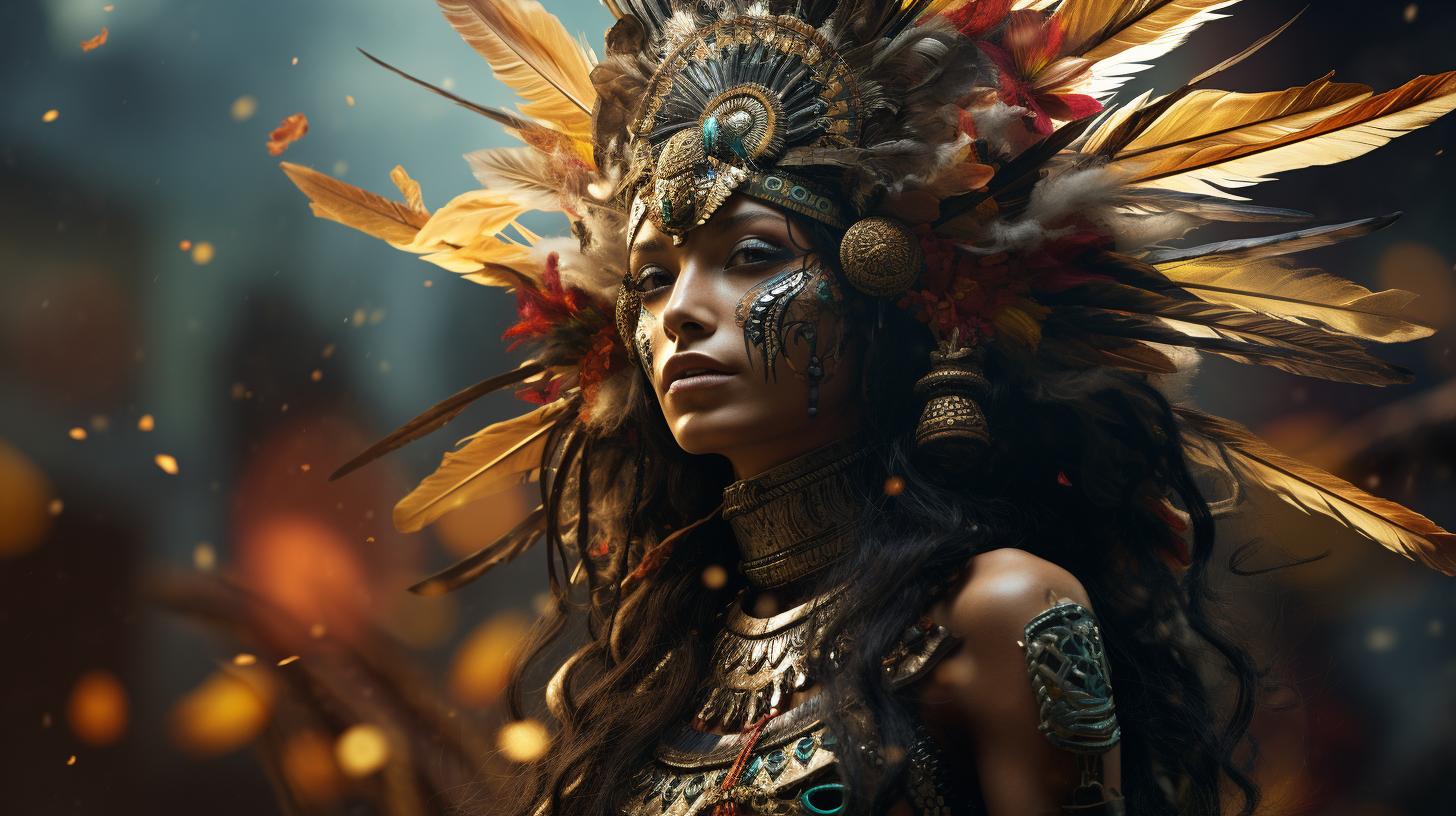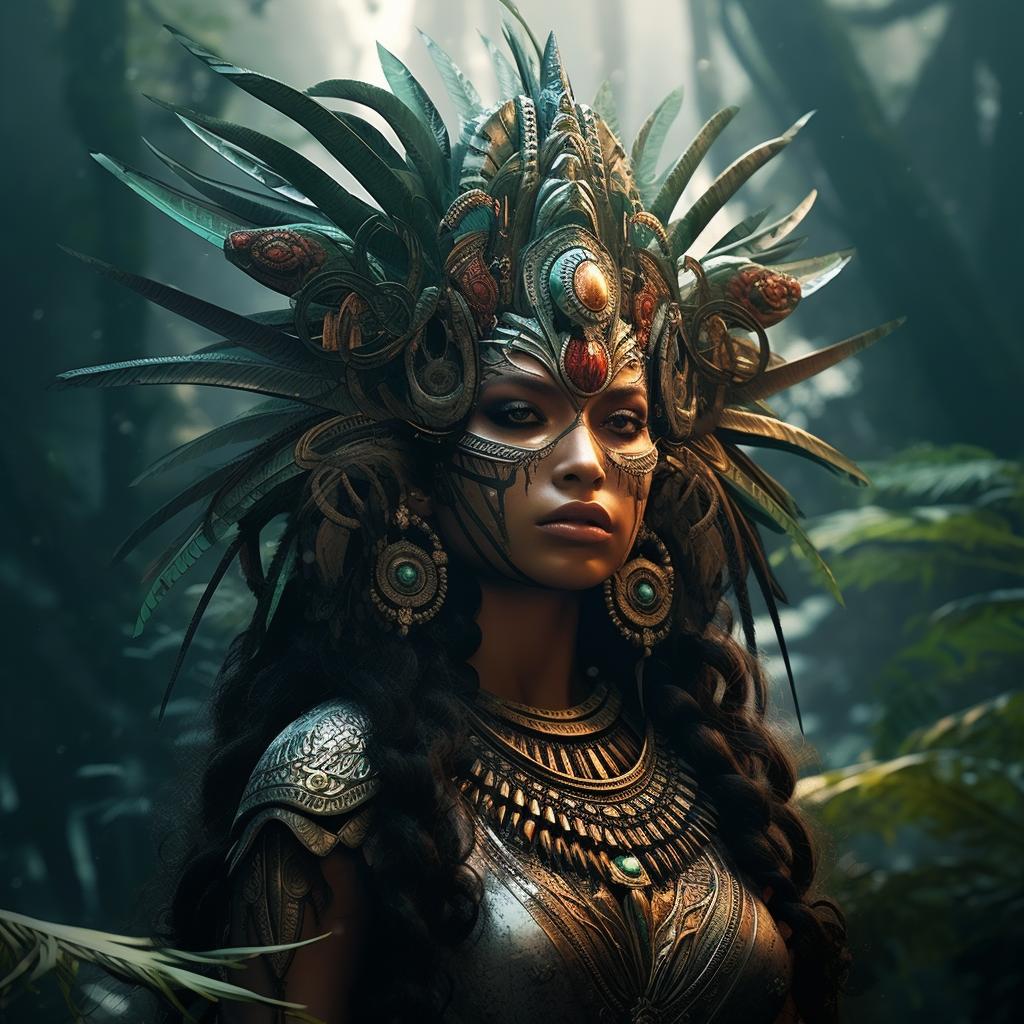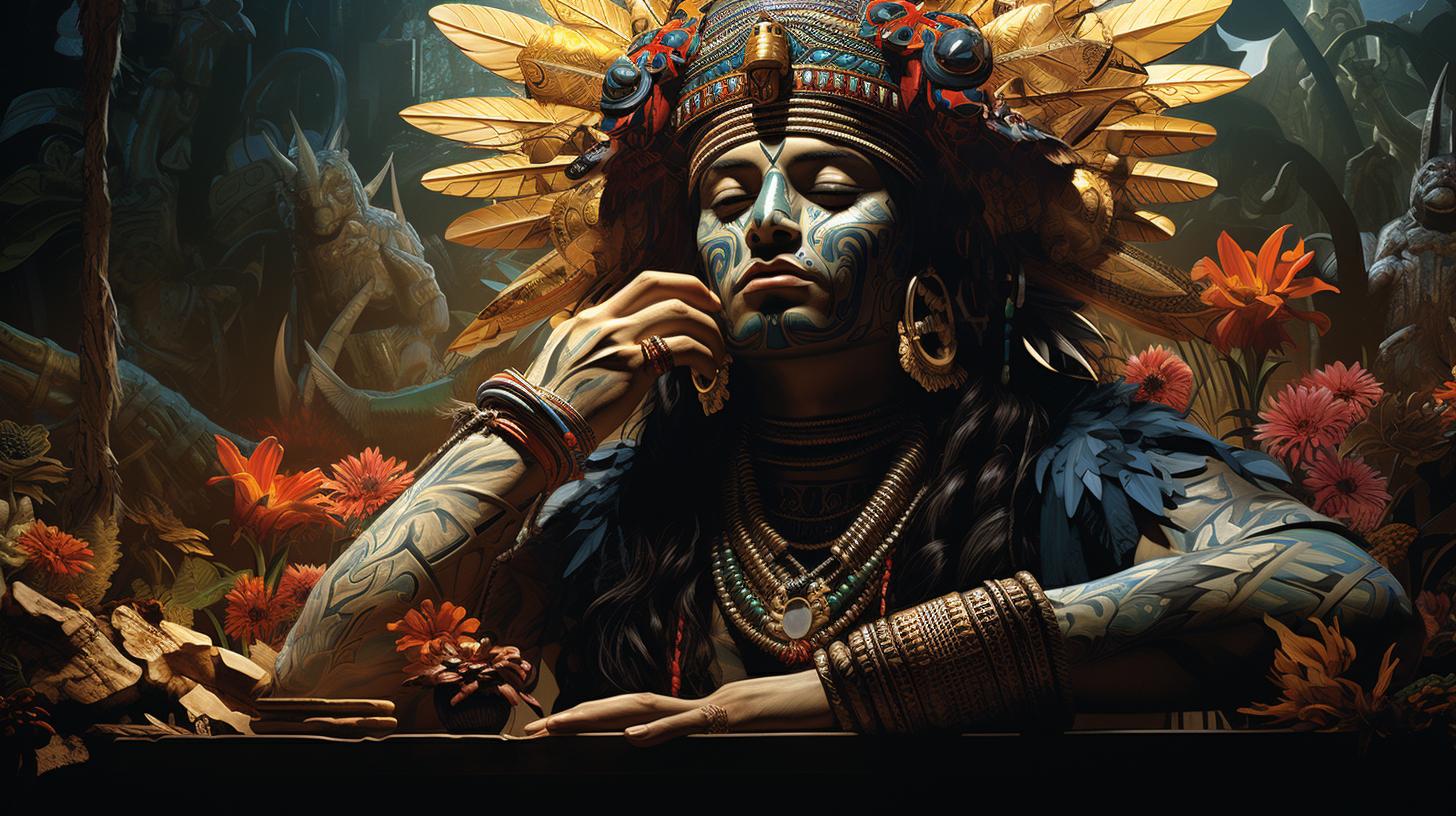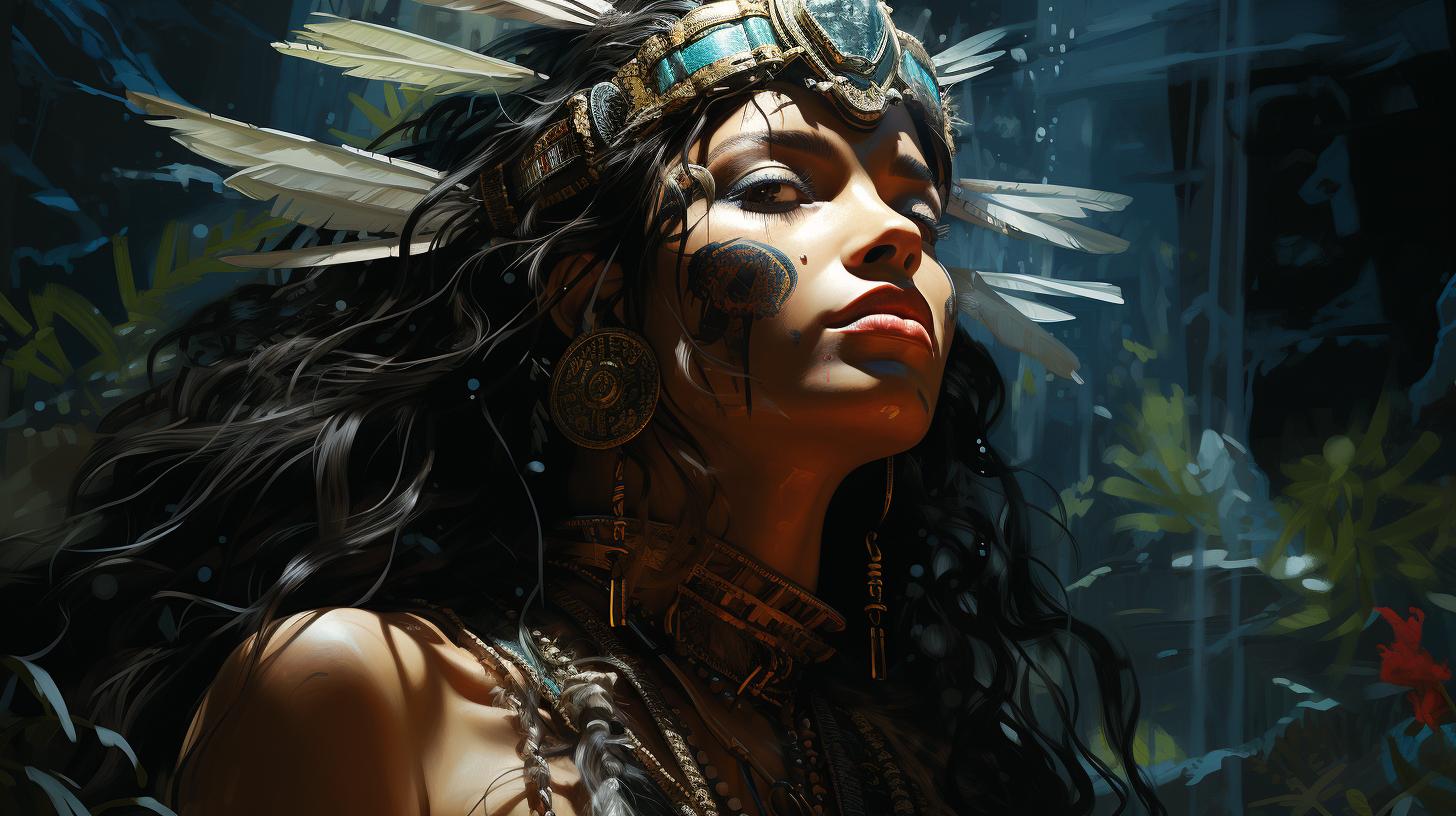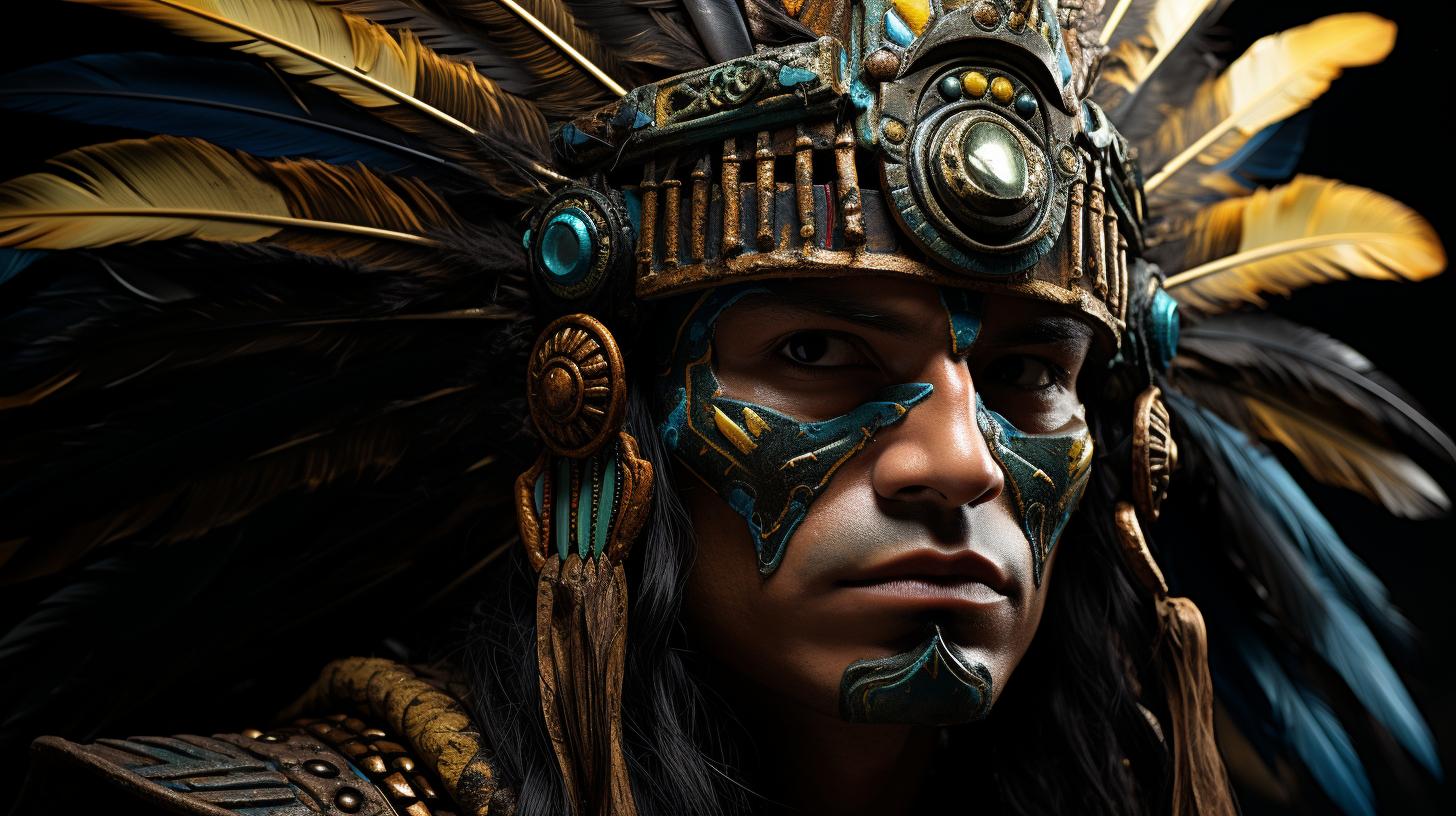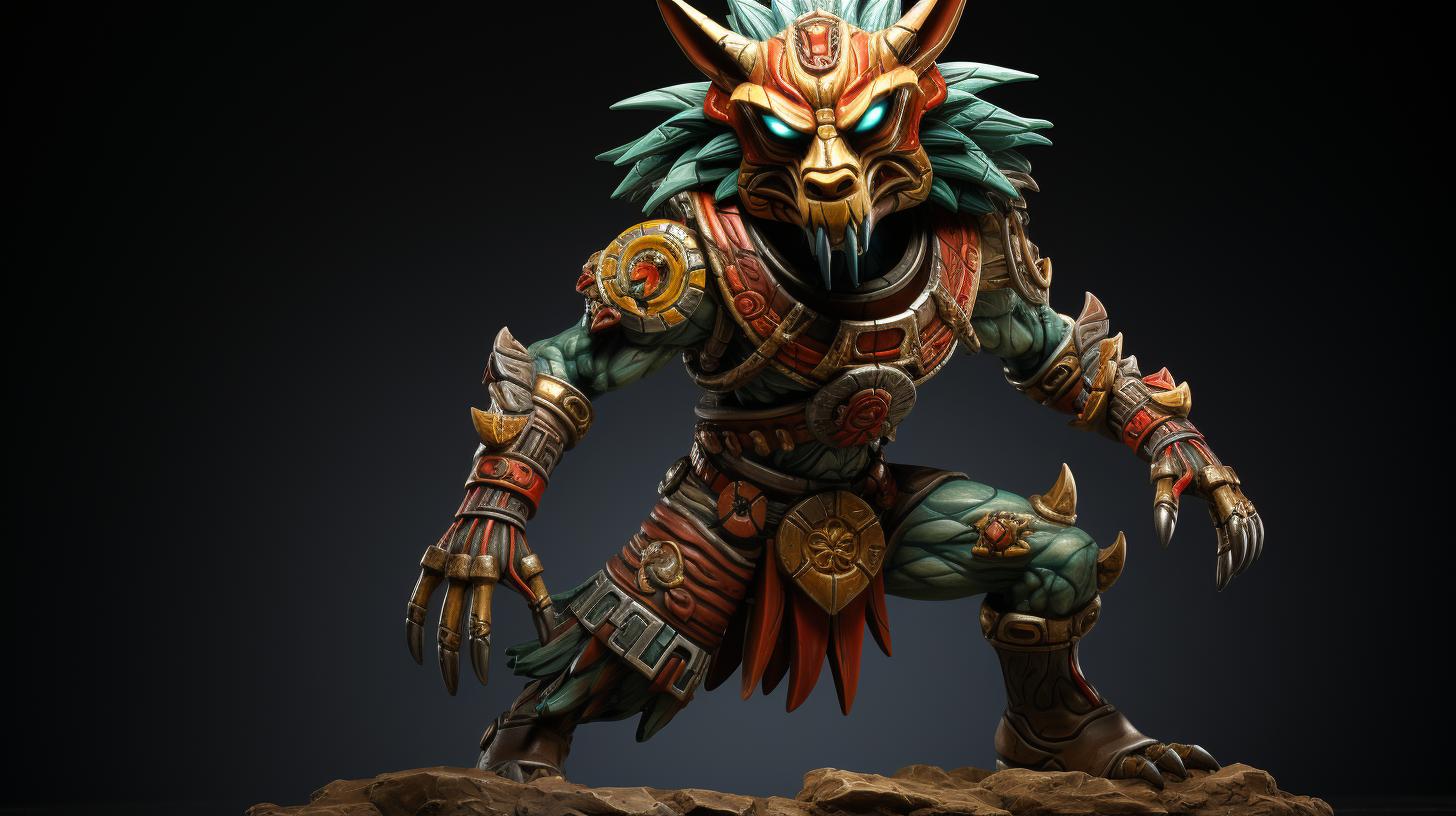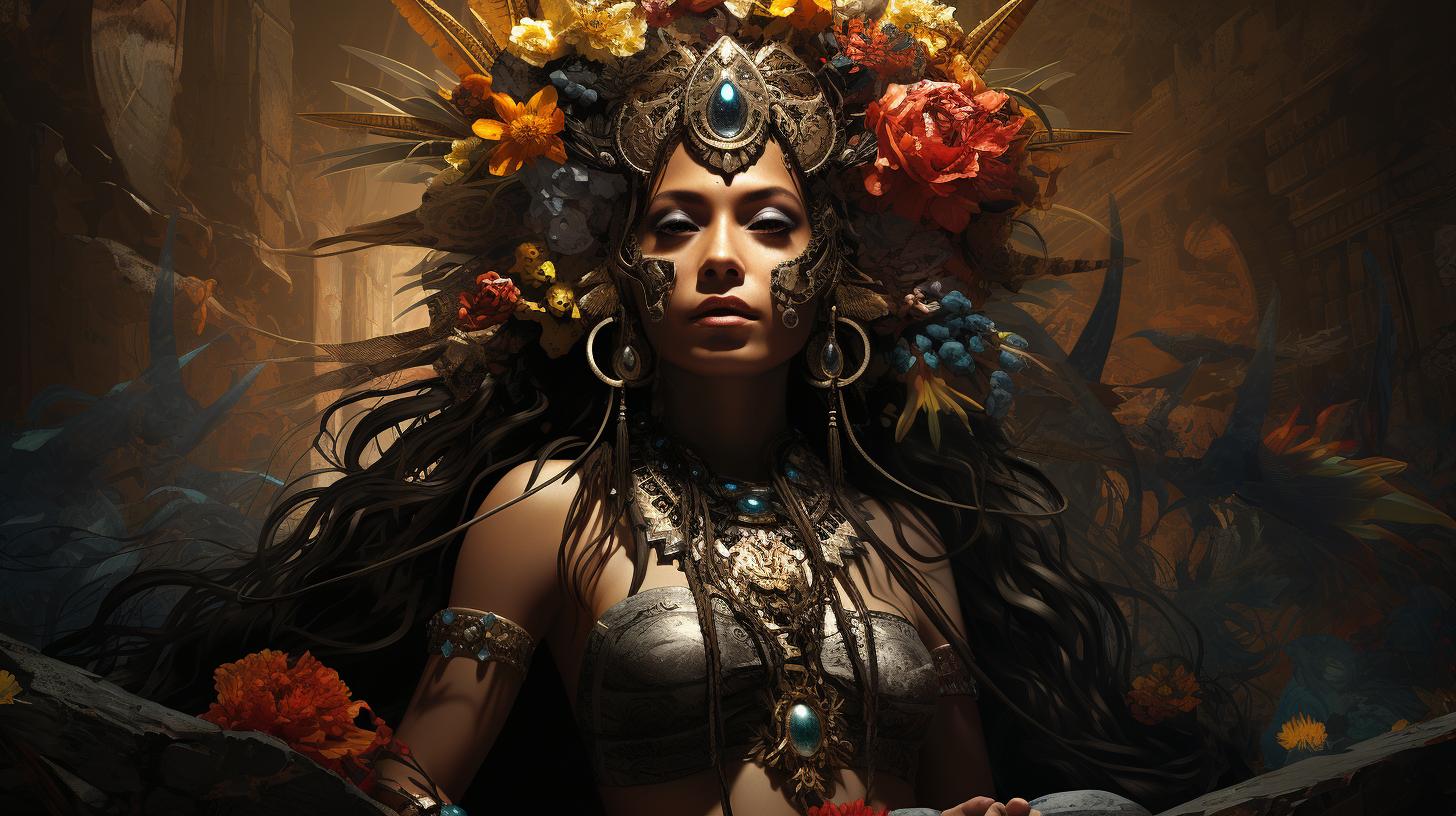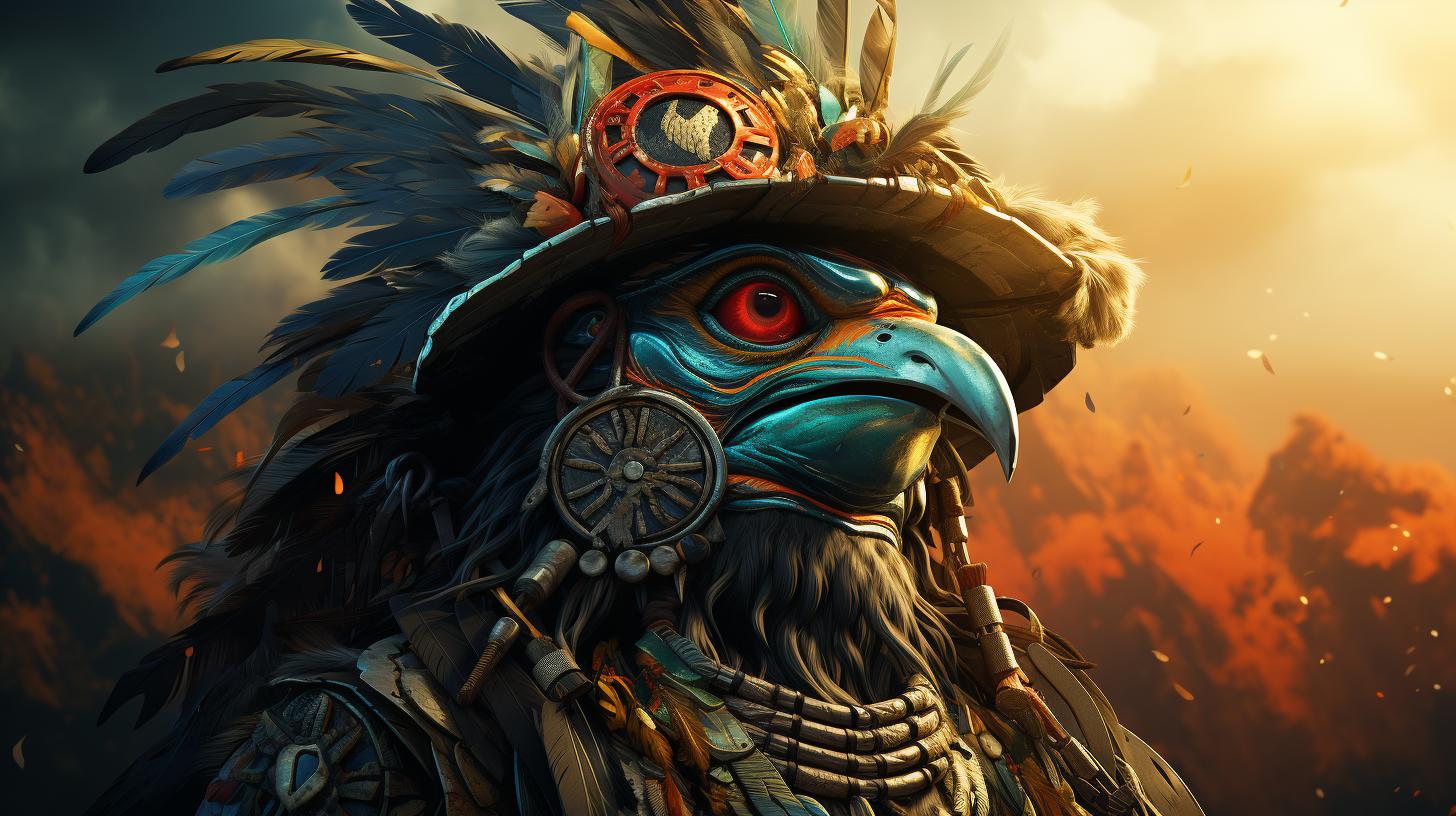Coyolxauhqui: The Mighty Aztec Moon Goddess Revealed
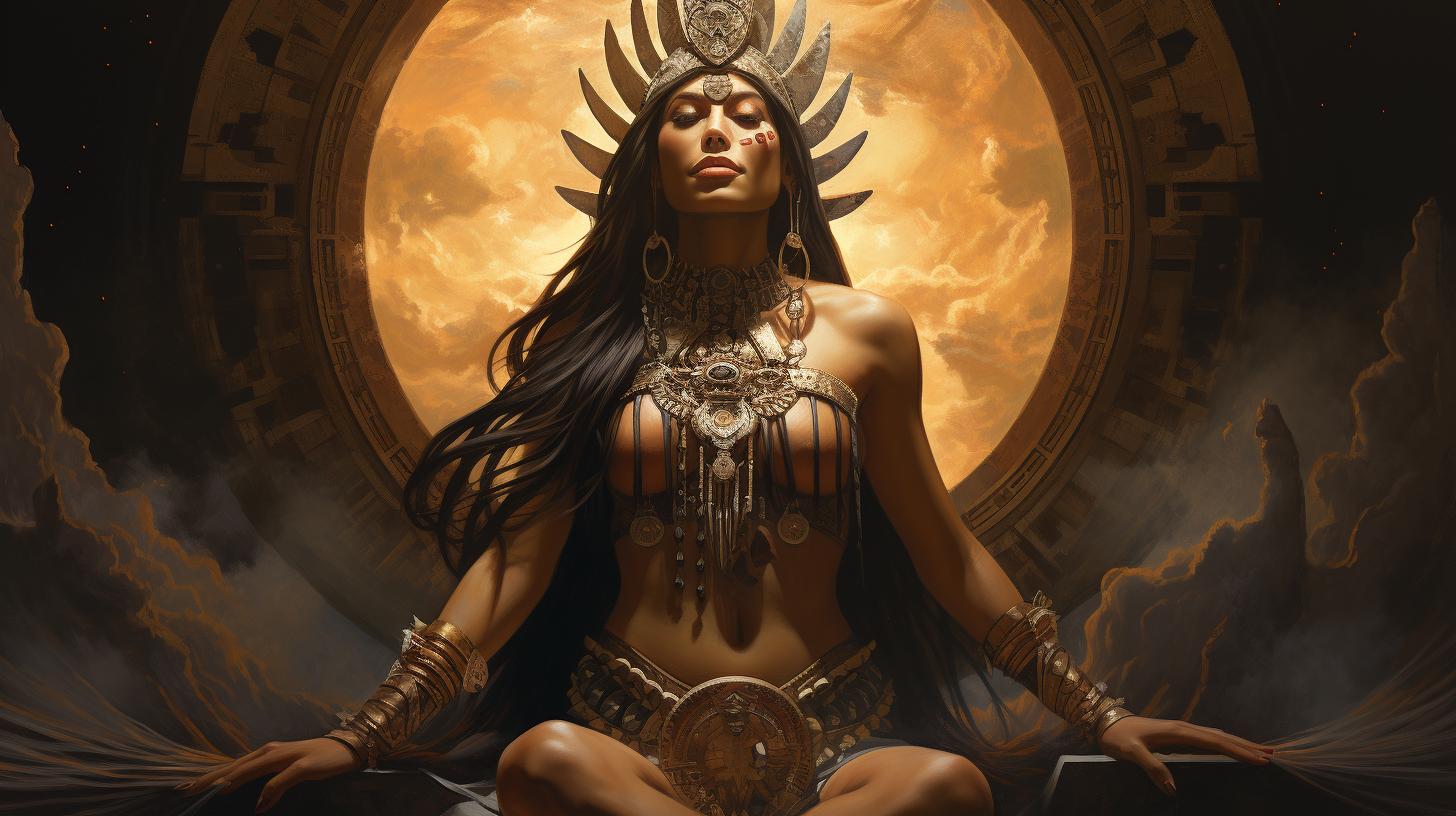
Coyolxauhqui, the Aztec Moon Goddess, holds a significant role in Aztec mythology. She is known for leading a failed attack against her mother, Coatlicue, while she was carrying the miraculous god Huitzilopochtli. Huitzilopochtli, the god of war and patron of Tenochtitlán, defended himself by decapitating Coyolxauhqui.
Her story is represented through various artistic depictions, including the renowned Stone of Coyolxauhqui. This article explores the mythology, symbolism, and cultural significance surrounding Coyolxauhqui, shedding light on the captivating world of Aztec cosmology and religion.
Background of Aztec Mythology
The Aztec civilization, known for its rich cultural and religious practices, has left a lasting impact on the world. Understanding the background of Aztec mythology is essential to comprehend the significance of Coyolxauhqui, the Aztec Moon Goddess.
The Aztec Culture and Religion
The Aztecs were an indigenous civilization that thrived in Mesoamerica from the 14th to the 16th century. They built a complex society centered around Tenochtitlán, their capital city, which is present-day Mexico City.
The Aztec religion, ingrained in their culture, played a pivotal role in their daily lives. Their religious beliefs were a blend of various Mesoamerican traditions, resulting in a unique spiritual system.
Key Deities in Aztec Mythology
Aztec mythology comprised a pantheon of gods and goddesses, each with their own significance and role in the cosmic order. Some of the key deities in Aztec mythology include:
- Huitzilopochtli: The patron god of Tenochtitlán and the Aztec god of war, sun, and sacrifice.
- Tlaloc: The rain god, associated with fertility and agriculture.
- Quetzalcoatl: The Feathered Serpent god, associated with wind, creation, and knowledge.
- Coatlicue: The mother goddess, associated with life, death, and rebirth.
These deities played vital roles in the Aztec worldview, shaping their religious rituals, beliefs, and societal practices.
The Goddess Coyolxauhqui
The goddess Coyolxauhqui holds a significant position in Aztec mythology, representing the powerful lunar deity within their pantheon. This section explores various aspects of Coyolxauhqui’s identity, role, and symbolism, shedding light on her importance and revered status in Aztec culture.
Introduction to Coyolxauhqui
Coyolxauhqui, often referred to as the Aztec Moon Goddess, emerges as a prominent figure within Aztec cosmology. Depicted as a fierce warrior and leader, she commands attention and interest as a central character in numerous mythological narratives.
Role and Significance of Coyolxauhqui
Coyolxauhqui’s role in Aztec mythology extends beyond her status as a lunar deity. She embodies the strength and determination of a warrior, leading her siblings in a rebellion against their mother, Coatlicue.
Her defiance and subsequent defeat at the hands of Huitzilopochtli carry profound symbolism, reflecting the cyclical nature of life, death, and rebirth in Aztec beliefs. Moreover, Coyolxauhqui’s defeat serves as a reminder of the powers that Huitzilopochtli possessed and the protective nature he offered to the Aztec people.
She represents both the challenges and consequences faced when opposing divine forces, a cautionary tale for those who dared challenge the gods in Aztec society.
Symbolism and Representation of Coyolxauhqui
The depiction of Coyolxauhqui in art and artifacts captivates the imagination and reveals profound symbolism in Aztec culture. Her representation often showcases her decapitated form or severed limbs, emphasizing the consequences of her rebellion against Huitzilopochtli.
Symbolically, Coyolxauhqui represents more than a defeated goddess; she embodies the connection between the moon, femininity, and the natural world. As the lunar deity, she represents the ebb and flow of time, the nurturing and transformative aspects of femininity, and the cyclical nature of the cosmos.
A number of artistic representations, including stone carvings and artifacts, capture the essence of Coyolxauhqui’s symbolism. These artistic expressions highlight her importance as a symbol of both power and vulnerability.
- Stone carvings and sculptures depict Coyolxauhqui’s severed body parts, symbolizing her defeat and the transformative power of Huitzilopochtli.
- Other artifacts, such as precious stones or figurines, offer different aspects and interpretations of Coyolxauhqui, showcasing her connection to nature and fertility.
These representations stand as a testament to the artistic prowess of the Aztec civilization and their ability to capture complex mythological narratives through intricate craftsmanship.
The Tale of Coyolxauhqui’s Defeat
The story of Coyolxauhqui’s defeat is a prominent episode in Aztec mythology that holds deep cultural significance. This section explores the mythological story of Coyolxauhqui’s battle, the triumphant god Huitzilopochtli, and the symbolic meaning behind this tale.
Mythological Story of Coyolxauhqui’s Battle
In Aztec mythology, Coyolxauhqui, the goddess of the moon, led an attack against her mother, Coatlicue, who was miraculously pregnant with the god Huitzilopochtli. Fueled by jealousy and fear of losing power, Coyolxauhqui gathered her brothers and launched a violent assault on Coatlicue.
The mythological narrative recounts how Huitzilopochtli, the god of war and patron of Tenochtitlán, emerged from his mother’s womb fully grown and armed. Sensing the imminent danger, Huitzilopochtli thwarted the attack by engaging in a fierce battle against Coyolxauhqui and her siblings.
In a display of his divine prowess, he ultimately triumphed and beheaded Coyolxauhqui.
Huitzilopochtli: The God Who Triumphed
Huitzilopochtli emerged as the hero of the myth, as his victory over Coyolxauhqui secured his place as a prominent deity in Aztec cosmology. As the god of war, Huitzilopochtli symbolized bravery, strength, and protection for the Aztec people.
His triumph over Coyolxauhqui represented the eternal cycle of life, death, and rebirth. According to legend, Huitzilopochtli threw Coyolxauhqui’s decapitated body down the slopes of the Coatepec mountain and cast her head into the sky, where it transformed into the moon.
This cosmic event symbolized the continuous rhythm of the celestial bodies and their interconnectedness with earthly existence.
Symbolic Meaning of the Story
The tale of Coyolxauhqui’s defeat holds several symbolic layers within Aztec culture. It represents the struggle between light and darkness, as Huitzilopochtli‘s victory brings forth the light of day while Coyolxauhqui, now the moon, illuminates the night sky.
Furthermore, the story underscores the significance of loyalty and devotion to Huitzilopochtli as the patron deity of the Aztec capital, Tenochtitlán. It served as a reminder of the Aztecs’ resilience in the face of conflict, uniting them under a shared identity and reinforcing their cultural values.
The mythological tale’s enduring legacy is evident in its artistic representations and cultural artifacts, solidifying the importance of Coyolxauhqui’s defeat as a core aspect of Aztec belief systems.
- The battle between Coyolxauhqui and Huitzilopochtli symbolized the eternal struggle between light and darkness.
- Huitzilopochtli‘s victory represented the triumph of bravery and protection over chaos and discord.
- The transformation of Coyolxauhqui’s severed head into the moon symbolized the inseparable connection between the celestial bodies and earthly existence.
- The story emphasized the loyalty and devotion of the Aztecs to Huitzilopochtli, reinforcing their cultural identity and values.
- Artistic representations and artifacts depict the significant role of Coyolxauhqui’s defeat in Aztec belief systems.
Representations of Coyolxauhqui in Art and Archeology
Exploring the rich artistic and archaeological heritage of the Aztecs, the representations of Coyolxauhqui provide valuable insights into their religious beliefs and cultural practices.
Stone Carvings and Their Significance
The Aztecs were masterful artisans, and their stone carvings depicted various deities, including Coyolxauhqui. These intricate carvings showcased the goddess in dynamic poses, highlighting her power and significance. The attention to detail and precision in these stone carvings demonstrate the artistic skill and craftsmanship of the Aztec civilization.
The Stone of Coyolxauhqui: Discovery and Implications
One of the most notable archaeological finds related to Coyolxauhqui is the Stone of Coyolxauhqui, which was discovered in 1978 at the base of the Templo Mayor in Tenochtitlán. This magnificent relief carving depicts the defeat of Coyolxauhqui by Huitzilopochtli, symbolizing the triumph of the sun god over darkness and chaos.
The discovery of the Stone of Coyolxauhqui has provided invaluable knowledge about Aztec mythology and religious practices. Its intricate details and symbolism shed light on the cultural importance of Coyolxauhqui and the significance of her defeat to the Aztec worldview.
Other Artifacts and Depictions of Coyolxauhqui
Aside from the Stone of Coyolxauhqui, several other artifacts and depictions of the goddess exist. These include fragments of green stone slabs and a stone head, each offering unique insights into different aspects of Coyolxauhqui’s divinity and connection to nature.
Such artistic representations showcase the diverse artistic expressions of the Aztec civilization.
These artifacts not only attest to the artistic skills of the Aztecs but also provide glimpses into the religious and cultural significance of Coyolxauhqui within their society. They serve as visual reminders of her role as the moon goddess and the complexities of Aztec mythology.
By examining these representations, we gain a deeper understanding of Coyolxauhqui and her place in Aztec art and religious beliefs. These artistic depictions serve as a window into the vibrant and intricate world of the Aztec civilization.
Connections to Moon and Fertility
Within Aztec mythology, Coyolxauhqui’s association with the moon holds great significance. She embodies the lunar aspect, representing its power, cycles, and symbolism in Aztec cosmology. The moon was revered by the Aztecs as a celestial body influencing various aspects of life, including fertility, agriculture, and the natural rhythms of the world.
Coyolxauhqui’s Association with the Moon
Coyolxauhqui’s connection to the moon is illustrated through her name, which translates to “Golden Bells.” It is said that her golden headdress resembled a moon in its crescent phase. This association solidifies her status as the lunar deity in Aztec mythology and emphasizes her role in its celestial principles.
The moon’s influence on fertility and the cycles of life is deeply intertwined with Coyolxauhqui’s significance. As the moon waxes and wanes, so does the rhythm of nature, impacting the fertility of the land, the abundance of crops, and the growth of all living beings.
Fertility Symbols and Rituals
Within Aztec culture, fertility was a vital aspect of life and society. Coyolxauhqui’s role as a goddess of fertility is reflected in various symbols and rituals associated with her worship. These symbols often included depictions of fertility goddesses and agricultural motifs, such as corn, flowers, and water.
The Aztecs conducted rituals and ceremonies dedicated to Coyolxauhqui, seeking her blessings for prosperous harvests, healthy pregnancies, and the continuity of life. Offerings were made to honor her and to ensure the fertility of the land and people.
These rituals were essential for maintaining the balance between humans and nature within Aztec society.
The close relationship between Coyolxauhqui, the moon, and fertility emphasized the interconnectedness of celestial forces, the natural world, and the continuity of life. Understanding and honoring these connections was crucial for the Aztecs to thrive in their agricultural practices and ensure the prosperity of their civilization.
See Also other Aztec gods and goddesses
In addition to learning about Coyolxauhqui, the Aztec Moon Goddess, there are other fascinating topics and related subjects that you may find interesting. Explore further into the rich Aztec mythology and culture with the following:
Aztec Pantheon and Deities
- Discover the diverse array of gods and goddesses worshipped by the Aztecs, each with their own unique powers and significance in the pantheon.
- Uncover the tales and legends associated with deities such as Quetzalcoatl, Tlaloc, and Tezcatlipoca, understanding their roles in Aztec cosmology.
- Explore the rituals and practices dedicated to these divine beings and how they influenced the daily lives of the Aztec people.
Mexican Mythology and Deities
- Delve deeper into the broader world of Mexican mythology, examining the shared aspects and variations across different Mesoamerican cultures.
- Learn about other important deities worshipped in Mexican mythologies, such as the Mayan gods and goddesses or the Olmec supernatural beings.
- Understand the connections, influences, and exchanges between the Aztec religious beliefs and those of neighboring civilizations.
Art and Sculpture in Aztec Culture
- Appreciate the intricate craftsmanship and symbolism present in Aztec art, from the elegant featherwork to the magnificent stone sculptures.
- Explore the various artistic techniques employed in Aztec culture, including the vibrant codices, mural paintings, and intricate pottery.
- Uncover the cultural and religious significance of Aztec sculptures and how they captured the essence of deities, historical events, and everyday life.
By exploring these related subjects, you’ll gain a deeper understanding of the Aztec world and its rich cultural heritage.
Immerse yourself in the captivating realm of mythology, art, and spirituality that shaped the lives of the Aztec people and continues to inspire awe and fascination today….











